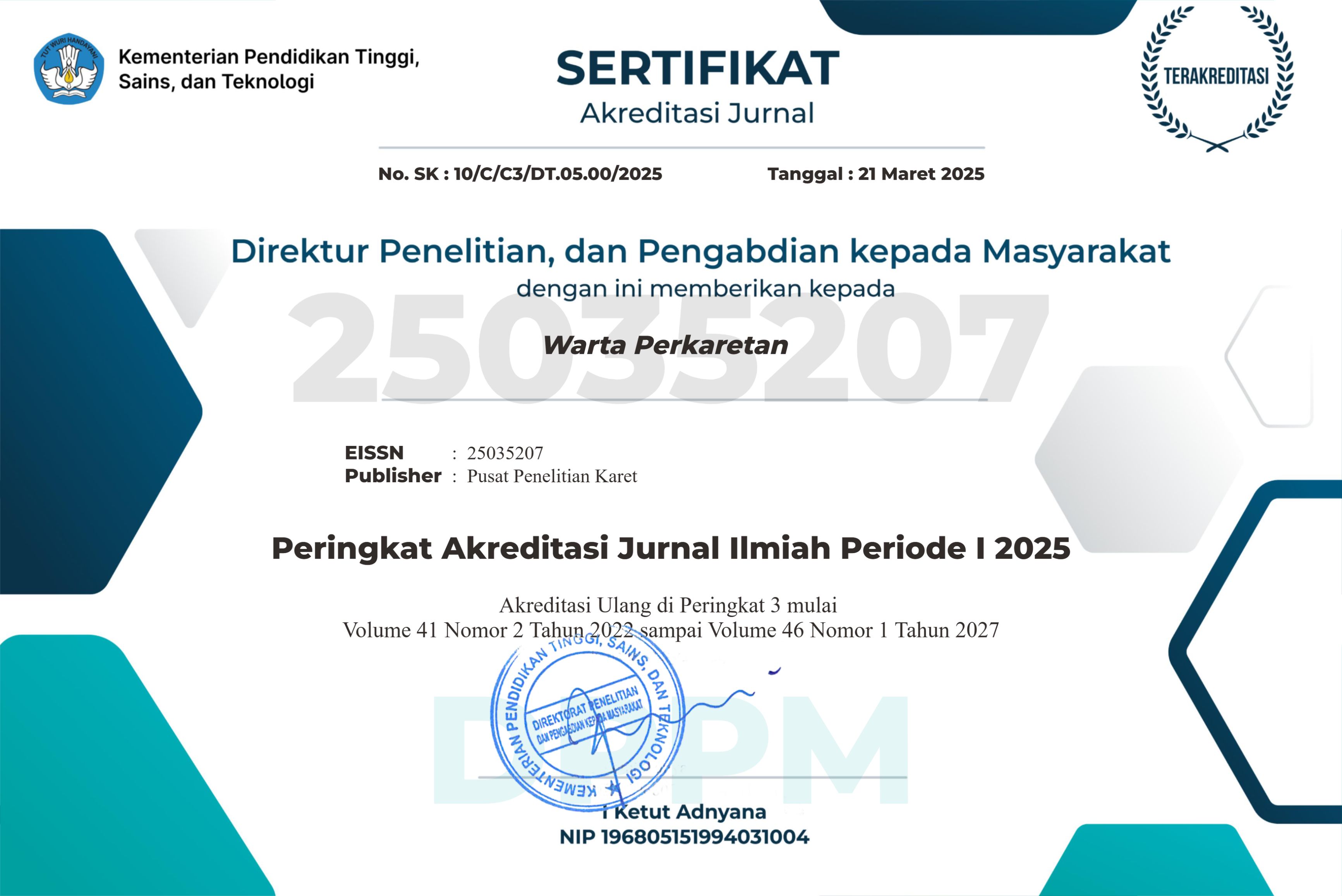EMISI GAS RUMAH KACA DI PERKEBUNAN KARET
DOI:
https://doi.org/10.22302/ppk.wp.v35i2.95Keywords:
Hevea brasiliensis, CO2, N2O, carbon sequestration, eddy covarianceAbstract
Carbon dioxide (CO2) and nitrous oxide (N2O) and methane (CH4) are three of the major greenhouse gas (GHG). Agricultural sector accounts for 10-14% of global athropogenic GHGs. The research of GHGs in rubber plantation has been started in several rubber producer countries including Indonesia however the progress is not as fast as in other agricultural commodities. Carbon stock and carbon balance in rubber plantation is the trending research topic. Biometric and eddy coveriance are the two methods that are used for investigating carbon emission. The results of some study using those two methods indicate that the similar result i.e. the amount carbon that is released by rubber plantation ecosystem is tended to be smaller than carbon absorption. The amount of CO2 that absorbed by rubber plantation is approximately 29-40 tons CO2 ha/year. Commonly the previous studies are mostly conducted in establish area, which mean the study is not designed with some treatments such as fertilizer and organic matter dosage, time of application, soil tillage. The deeply study of carbon emission, related to field management to carry out the best management practices and environmental friendly is still needed. The similar study concerning other gas like N2O in rubber plantation is also important to be conducted. It is due to the application of nitrogen fertilizer and organic matter in rubber plantation is high enough. There are some opportunities to conduct research consortium with other research institutions and universities in order to solve the high cost in GHGs research.References
Anderson JPE. 1982. Soil Respiration. In: Page AL, Miller RH, Keeney DR (eds). Method of Soil Analysis Part 2, Chemical and Microbiological Properties. Soil Science Society America. Madison. USA.
Annmalainathan K, Satheesh PR, Jacob J. 2011. Ecosystem flux measurements in rubber plantations. Natural Rubber Research. 24(1): 28-37.
Baldocchi DD. 2003. Assessing the eddy covariance technique for evaluating carbon dioxide exchange rates of ecosystem: past, present and future. Global Change Biology. 9: 1-14.
Barr AG, Black TA, Hogg EH, Kljun N, Morgenstern K, Nesic Z. 2004. Inter-annual variability in the leaf area index of a boreal aspen-hazelnut forest in relation to net ecosystem production. Agricultural and Forest Meteorology. 126: 237-255.
Chantuma A, Kunarasiri A, Chantuma P. 2012. Rubber new planting in Thailand: towards the world affected on climate change. Rubber Thai Journal. 1:40-47.
Chung-Wang X, Ceulemans R. 2004. Allometric relationships for below and aboveground biomass of young scots pines. Forest Ecology and Management. 203: 177-186.
FAO 2006. Faostat data, 2006. http://faostat.fao.org
Gibs HK, Brown S, Niles JA. 2007. Monitoring and estimating tropical forest carbon stocks: making REDD a reality. Environmental Research Letters. 2: 1-13.
IPCC (Intergovernmental Panel on Climate Change). 2007. Climate Change 2007: Mitigation of Climate Change: Contribution of Working Group III to the Fourth Assessment Report of the Intergovernmental Panel on Climate Change. Cambridge University Press, UK.
IRRDB. 2009. The effect of climate change on NR cultivation and productivity. Paper on IRRDB conference 30th November 2009.
Kirschbaum MUF, Eamus D, Gifford RM, Roxburgh SH, Sands PJ. 2001. Definitions of some ecological terms commonly used in carbon accounting. In: Kirschbaum MUF, Mueller R (eds). Net Ecosystem Exchange Workshop, 2001 April 18-20, Canberra Australia. CRC. 2-7p.
Kool DM, Dolfing J, Wrage N, Van Groenigen JW. 2011. Nitrifier denitrification as a distinct and significant source of nitrous oxide from soil. Soil Biology & Biochemistry. 43: 74-178.
Lefsky MA, Cohen WB, Harding DJ, Parker GG, Acker SA. 2001. LiDAR remote sensing of above-ground biomass in three biomass. Global Ecology and Biogeography. 11: 393-399.
Lu D. 2005. Aboveground biomass estimation using Landsat TM data in the Brazilian Amazon. International J Remote Sens. 26: 2509-2525.
Nelson R, Krabil W, Tonelli J. 1988. Estimating forest biomass and volume using airborne laser data. Remote Sensing of Environment. 24: 247-267.
Nhu TP, Ki HK, Parker D, Eui CJ, Jae HS, Chang SC. 2012. Effect of beef cattle manure application rate on CH4 and CO2 emissions. Atmospheric Environment. 63: 327-336.
Nugroho PA. 2015. Soil N2O and CO2 fluxes under different crop and fertilizer management in Southern Hokkaido Japan [Thesis]. Bogor: Institut Pertanian Bogor.
Pradipta, A. 2012. Kajian penggunaan amelioran pupuk kandang terhadap emisi gas rumah kaca pada tanah yang diambil dari beberapa agroekosistem kebun karet di lahan gambut [Thesis]. Bogor: Institut Pertanian Bogor.
Ravindranath NH, Ostwald M. 2008. Methods for estimating above ground biomass. In: Ravindranath NH and Ostwald M (eds). Carbon inventory methods: Handbook for greenhouse gas inventory, carbon mitigation and roundwood production projects. Springer Science + Business Media B.V 113-114.
Risk N, Snider D, Wagner-Riddle C. 2013. Mechanisms leading to enhanced soil nitrous oxide fluxes induced by freeze-thaw cycles. Canadian Journal of Soil Science. 93: 401-414.
Saungreksawong C, Khamyong S, Anongrat N, Pinthong J. 2012. Growth and carbon stocks para rubber plantations on phonpisai soil series in Northeastern Thailand. Rubber Thai Journal. 1:1-18.
Shimizu M, Marutani S, Desyatkin AR, Jin T, Hata H, Hatano R. 2009. The effect of manure application on carbon dynamics and budgets in a managed grassland of Southern Hokkaido, Japan. Agriculture Ecosystem and Environment. 130: 31-40.
Shimizu M, Hatano R, Arita T, Kouda Y, Mori A, Maatsura S, Niimi M, Jin T, Desyatkin AR, Kawamura O, Hojito M, Miyata A. 2013. The effect of fertilizer manure application on CH4 and N2O emissions from managed grasslands in Japan. Soil Science Plant Nutrition. 5: 69-86.
Steininger MK. 2000. Sateleite estimation of tropical secondary forest above ground biomass: data from Brazil and Bolivia. International Journal of Remote Sensing. 21: 1139-1157.
Susilawati, S. 2011. Pendugaan cadangan karbon (Carbon Stock) dan neraca karbon pada perkebunan karet [Skripsi]. Bogor: Institut Pertanian Bogor.
Toma Y, Hatano R. 2007. Effect of crop residue C: N ratio on N2O emissions from gray lowland soil in Mikasa Hokkaido Japan. Soil Science Plant Nutrition. 53: 198-205.
Vashum KT, Jayakumar S. 2012. Methods to Estimate Above-Ground Biomass and Carbon Stock in Natural Forests-A Review. Journal of Ecosystem Ecography. 2:116.








